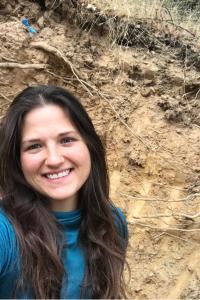Kimber is on a mission to connect people to the land in hopes that this connection will lead to the healing and vitality of our ecosystems. She does this through research, outreach, and science communication.
Kimber's story began in the shadow of the Rocky Mountains, where she nurtured a curiosity about the world around her. This curiosity led her to Regis University in Colorado, where she earned a Bachelor's degree in biology, ecology, and evolution. It was here, that she uncovered the profound significance of healthy soil—the thin top layer of the Earth that separated life from lifelessness.
Inspired by the magic beneath our feet, Kimber set her sights higher, aiming to understand the soil system and its connection to the world around us. The University of California, Merced, became her next stop, where she pursued a doctoral degree in soil biogeochemistry. Soil, she discovered, was not merely dirt in our fingernails; it was a repository of carbon and life, storing and holding onto carbon for millennia. Her work focused on the interplay between climate change and carbon and nitrogen storage and persistence from the topsoil down to bedrock in the Southern Sierra Critical Zone Observatory.
With her newfound expertise, Kimber emerged as a lead principal investigator at Lawrence Livermore National Labs. There, she explored the depths of the Earth, delving down to 16 meters to unravel the mysteries of soil carbon and nitrogen dynamics. While at the lab she ventured into the heart of indigenous wisdom by collaborating with the Karuk tribe. Together, they sought to use science in hopes that it could help the tribe bring back burning practices through understanding its impact on soil carbon dynamics. Her other projects extended to exploring the aftermath of wildfires on soil carbon amount and persistence in deep soil ecosystems and she experimented with different soil amendments, particularly enhanced rock weathering, and its impact on microbiology and organic matter in agricultural lands.
Today, Kimber finds herself in a new chapter of her adventure. As a fresh addition to the California Climate Hub, she focuses on the art of communication—translating the language of climate science for the benefit of NRCS and extension staff. Her passion lies in sharing knowledge to inspire and equip others with the tools needed for thoughtful land stewardship. Kimber's inquisitive spirit now guides her research into Sierra Nevada meadow restoration and its impact on soil carbon storage. Please reach out to Kimber with any questions you may have. For more about Kimbers work please check out: Kimbermoreland.com
Featured Work:
Hunter., B., Roering., J., Silva, L., Moreland., K. (2023) Geomorphic controls on the abundance and persistence of soil organic carbon pools in erosional landscapes. Nature Geoscience.
Moreland, K., Dove, N., Yan, Q., Barnes, M., Hou, T., Hart, S., Filley, T., Berhe, A. A. (In Publication: Springer) Viewing organic matter dynamics under a Critical Zone “lens”: A holistic framework for increased understanding and better predictions. In: Critical Zone Advances.
Moreland, K., Tian, Z., McFarlane, K., Hart, SC., Bales, R., Hartsough, P., O’Geen, A., Berhe, A. A. (2022). Climatic controls on soil and saprock nitrogen distribution and persistence in the Sierra Nevada.Journal of Plant Nutrition and Soil Science. DOI: 10.1002/jpln.202200218
Yang, Y., Berhe, A. A., Barnes, M., Moreland, K., Tian, Z., Kelly, A., Bales, R., O’Geen, A., Goulden, M., Hartsough, P., Hart., S. (2022). Potential impact of warming on nutrient storage in seasonally dry forests: insights from an elevation gradient. Global Biogeochemical Cycles. DOI: 10.1029/2022gb007429
Longbottom, T., Wahab, L., Jurusik, A., Moreland, K., Dolui, M., Min, K., Thao, T., Gonzales, M., Rojas, Y., Alvarez, J., Malone, Z., Ghezzehei., T., Berhe, A. A. (2022) What’s soil got to do with climate change? Geological Society of America. DOI: 10.1130/GSATG519A.1
Reed, C., Berhe, A. A., Moreland, K., Wilcox, J., Sullivan, B. Restoring function: positive responses of carbon and nitrogen to 20 years of hydrologic restoration in montane meadows. (2022). Ecological Applications. DOI: 10.1002/eap.2677
Dove, N., Barnes, M., Moreland, K., Hartsough, P., O’Geen, A., Graham, R., Berhe, A. A., Hart, S. (2021). Depth dependence of climatic controls on soil microbial community activity and composition. ISME Communications. DOI: 10.1038/s43705-021-00081-5
Moreland, K., Tian, Z., McFarlane, K., Hart, S. C., Bales, R., Hartsough, P., O’Geen, A. Berhe, A. A. (2021) Deep in the critical zone: weathered bedrock represents a large, potentially active pool of soil carbon. Environmental Research Letters. DOI: 10.1088/1748-9326/ac3bfe
Santos, F., Abney, R., Barnes, M., Jin, L., Moreland, K., Bogie, N., Sulman, B., Ghezzehei, T. A., Berhe, A. A. (2019). The role of soil physical properties for determining biogeochemical responses to soil warming. In: Ecosystem Consequences of Soil Warming: Microbes, Vegetation, Fauna and Soil Biogeochemistry. DOI: 10.1016/C2016-0-04891-X


